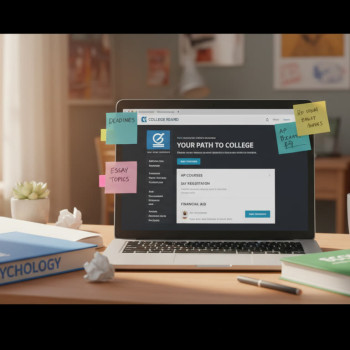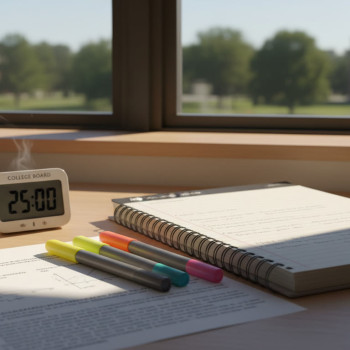Why Publish Your AP Capstone?
You spent months—maybe a year—on an AP Capstone project. Whether it was AP Seminar or AP Research, that capstone represents original thinking, deep research, and intellectual grit. Publishing that work does more than decorate a résumé: it validates your voice, sharpens your communication skills, and positions you as a young scholar ready to contribute to a field.
Think of publication not as a one-shot trophy but as an opportunity to refine your craft. A published capstone can open doors—college admissions officers notice sustained, tangible academic engagement, scholarship panels take interest in documented research experience, and future mentors or collaborators can actually read what you’ve done.
Is My AP Capstone Ready to Publish?
Not every student project is immediately ready for publication—and that’s okay. Use the following checklist to judge readiness:
- Original contribution: Does your project add something new—an interpretation, method, dataset, or perspective?
- Clarity of question: Is your research question tightly defined and well-motivated?
- Sound methodology: Are your methods appropriate, described clearly, and repeatable?
- Ethical compliance: Have you addressed consent, data privacy, and participant protections if relevant?
- Polished prose: Can your narrative and argument be followed by someone outside your classroom?
- Evidence and references: Have you cited sources properly and placed your work in the context of existing literature?

Step 1 — Reframe Your Capstone for an Audience
Academia and classrooms value rigor; publishers value clarity and audience. Reframing means asking: Who will read this piece? A general undergraduate admissions reader? A subject-specific journal? A public magazine for teens? The answer will determine style, depth, technical language, and supplementary material.
From Internal Report to External Narrative
Classroom reports sometimes assume shared knowledge. For publication, you must build context quickly: define terms, sketch the problem, and state why the reader should care in the first paragraph. Use storytelling elements where appropriate—set up a compelling scene, pose the tension, then resolve with evidence and insight.
Structure Matters: Models You Can Use
- Short-form article (1,000–1,500 words): Ideal for general student publications or online platforms. Focus on the main findings and implications.
- Long-form (2,000+ words): Better for subject journals or campus research magazines; include methods, data, and a literature conversation.
- Poster or visual report: Great for conferences or institutional showcases—use infographics and concise captions.
Step 2 — Tighten the Research and Method Section
Editors and reviewers want reproducibility and rigor. Even if your audience is non-technical, you should be able to explain your method simply and defend your choices convincingly.
Practical Ways to Improve Methods
- Be explicit about sampling: How did you choose participants or data points? What are the limits?
- State tools and processes: Were surveys used? Interviews? Textual analysis? Which software or coding rules?
- Include dates and locations: These details matter for reproducibility and context.
- Discuss limitations: Transparency about what you couldn’t control strengthens credibility.
Example: Turning Classroom Methods Into Publishable Form
Classroom phrasing: “We surveyed 50 students about study habits.” Replace with: “Between March 1 and March 21, 2025, we administered an anonymous, IRB-exempt online survey to 50 high school juniors at X High School using Google Forms. Respondents were recruited via email; response rate was 62%. Survey items were piloted with five students for clarity. Data were analyzed using descriptive statistics and thematic coding for open-ended responses.”
Step 3 — Strengthen Your Argument and Literature Placement
Publication requires that you place your work in conversation with others. This shows that you understand the gap your project addresses.
How to Create a Strong Literature Context
- Summarize key prior work that informs your question, in one to three compact paragraphs.
- Explicitly state the gap or tension your research addresses.
- Position your findings as a response: how do they confirm, contradict, or refine existing ideas?
Tip: Use a ‘Bridge Paragraph’
After your literature review, include a short transition paragraph that connects previous research to your thesis: “While prior studies X and Y emphasized A and B, they have not explored C; this study examines C through…” That bridge helps the reader see the necessity of your work.
Step 4 — Revise for Readability and Flow
Good writing is the final mile that determines whether your research will be read and cited. Work deliberately on rhythm, sentence length, and paragraph transitions.
Practical Revision Checklist
- Lead with a strong opening paragraph that states the problem and your main finding in plain language.
- Keep paragraphs short—3–6 sentences. Each paragraph should make one point.
- Use signposting: “First,” “Next,” “Finally,” and headers help navigation.
- Cut passive voice where it weakens clarity. Active verbs accelerate reading.
- Read the piece aloud or use text-to-speech—errors and awkward phrasing become obvious.
Step 5 — Make Data and Visuals Work for You
Tables, charts, and images can transform dense findings into memorable insights. For publication, visuals should have clear captions, labelled axes, and accessible color choices.
Example Table: Candidate Presentation of Findings
| Section | What to Include | Why It Matters |
|---|---|---|
| Abstract | One-paragraph summary of question, method, result, and implication | Helps editors and readers decide relevance quickly |
| Introduction | Context, gap in literature, research question | Frames your contribution |
| Methods | Participants, instruments, procedures, analysis | Demonstrates rigor and reproducibility |
| Results | Clear presentation of data, visuals, and key patterns | Shows what you found objectively |
| Discussion | Interpretation, limitations, implications | Connects findings back to big questions |
| References | Accurate citations in a consistent style | Places work in scholarly context |
Step 6 — Choose the Right Venue
Not all publications are the same. The right venue depends on your aims: public impact, academic dialogue, or a polished piece for a college application portfolio.
Possible Venues and Their Strengths
- Student journals (school, regional, national): Good training ground with peer editors who understand student work.
- University undergraduate journals: Offer higher editorial standards and reach faculty readers.
- Specialized magazines or online platforms: Great for translating technical work for general audiences.
- Conference posters or undergraduate symposia: Useful for networking and live feedback.
How to Evaluate a Venue
- Read recent issues: Are the topics and quality a fit?
- Check submission guidelines: Word limits, citation style, and review type (peer or editorial).
- Consider turnaround time: Some journals take months; student magazines may be quicker.
Step 7 — Prepare Your Submission Package
Most venues ask for a manuscript and a cover letter. Be thorough and professional.
Cover Letter Essentials
- Concise project summary: 2–3 sentences that highlight significance.
- Why the journal: Briefly explain the fit with the publication.
- Authorship and acknowledgements: Note contributors, funding, or ethical approvals.
- Contact details and any conflicts of interest.
Step 8 — Navigate Ethics, Permissions, and IP
Publication introduces legal and ethical considerations—especially if your project involved human subjects, proprietary data, or copyrighted materials.
Quick Guide to Common Issues
- Human subjects: If interviews or surveys involved minors, document consent and any school approvals.
- Data privacy: Anonymize datasets and get permission before publishing raw responses.
- Image or content rights: Secure permission to reproduce photos, chart sources, or third-party text.
- Intellectual property: Understand who owns the work—students, schools, or sponsoring organizations may have claims.
Step 9 — Revision, Review, and Responding to Feedback
Rejections or revision requests are part of the process. Keep a growth mindset: each review is an opportunity to strengthen your argument and presentation.
How to Respond to Reviewer Comments
- Separate emotion from critique—reviews focus on improving clarity or rigor.
- Catalogue comments and create an action plan: major revisions first, then minor edits.
- When you resubmit, include a polite response letter outlining changes made and reasons for any disagreements.
Practical Timeline for Student Authors
Publication rarely happens overnight. Here’s a realistic timeline you can use as a planning tool.
| Step | Estimated Time |
|---|---|
| Reframe and revise manuscript | 2–6 weeks |
| Prepare visuals and supplementary materials | 1–3 weeks |
| Identify and contact potential venues | 1–2 weeks |
| Submission to decision | 4–16 weeks (varies widely) |
| Revisions and resubmission | 2–8 weeks |
| Final acceptance to publication | 2–12 weeks |
How to Get Help—Mentors, Editors, and Tutoring
You don’t have to do this alone. A trusted mentor, teacher, or an editorial partner can help you shape tone, refine argumentation, and polish the final draft. For students who want structured, one-on-one guidance, Sparkl’s personalized tutoring provides tailored study plans, expert tutors, and AI-driven insights—helpful for drafting stronger methods sections, practicing persuasive cover letters, and preparing submission-ready visuals.
Who to Ask for What
- Content and argument: Subject teachers or research mentors
- Editing and style: English teachers or writing center consultants
- Data and methods: Math or statistics teachers, or a quantitative tutor
- Formatting and submission strategy: An advisor familiar with student journals
Common Pitfalls and How to Avoid Them
Even excellent projects can stumble. Here are pitfalls students frequently encounter and practical solutions:
- Weak title or abstract: Spend time crafting a clear, compelling hook—edit these last.
- Overloading with jargon: If your audience is broad, translate key terms into plain language.
- Underestimating ethical requirements: Address consent and data privacy early to avoid delays.
- Submitting too hastily: Get at least two rounds of feedback before you hit submit.
Real-World Examples and Mini Case Studies
Example 1: A student researching urban green spaces reframed local survey data into a comparative article exploring how access to parks affects reported well-being across neighborhoods. They rewrote the methods for clarity, added simple, attractive charts, and published in a statewide student research journal. The piece later became a talking point in a city youth advisory meeting.
Example 2: An AP Research team studying machine learning bias simplified their technical sections for an undergraduate audience and produced an interactive poster for a summer symposium. That poster highlighted concrete recommendations for fairer training datasets and won an award for clarity—an achievement they included in their college applications.
Using Publication as a Springboard
Publication is not an end point; it’s a platform. Once published, consider these next steps:
- Share the piece on a personal portfolio or LinkedIn with a short reflective note about what you learned.
- Adapt the content for presentations or school talks—practice explaining the work to varied audiences.
- Build on the research: a published capstone can justify follow-up studies, summer projects, or independent research in college.
Final Words: Publish with Purpose
Turning your AP Capstone into a publishable piece asks you to be both scientist and storyteller: rigorous in method, generous in explanation, and intentional about impact. Whether your aim is to influence local policy, strengthen an application, or simply share findings with a broader audience, the act of publishing refines your thinking and gives your work a life beyond the classroom.
Remember: the process takes time, feedback, and resilience. Use mentors, peer reviewers, and resources like Sparkl’s personalized tutoring when you need focused support. The payoff—seeing your name on a byline and knowing your ideas are part of a larger conversation—is worth the effort.
Quick Checklist Before You Submit
- Clear audience and venue chosen
- Polished abstract and opening paragraph
- Methods described with reproducible detail
- Figures/tables labeled and captioned
- Permissions and ethics documented
- At least two rounds of feedback completed

Parting Encouragement
Publishing your AP Capstone is an act of confidence and craft. You already have the seeds: curiosity, evidence, and sustained effort. With careful reframing, rigorous revision, and the right support, that classroom achievement can become a public contribution. Start small, aim thoughtfully, and celebrate every revision—each one brings your idea closer to readers who need to hear it.
Now take a breath, pick your favorite paragraph, and begin the first revision. You’ve earned the chance to be read—make it count.



















No Comments
Leave a comment Cancel